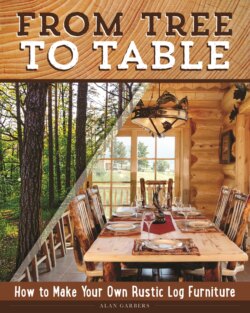Читать книгу From Tree to Table - Alan Garbers - Страница 15
На сайте Литреса книга снята с продажи.
Cutting the Wood in the Right Season
ОглавлениеThese days, when you buy firewood or lumber, it is often labeled “seasoned,” implying it has dried for a season. Historian, artist, and writer Eric Sloane had another theory. “Seasoned” wood was wood that our ancestors cut in the right season. That’s what we need to do. Our logs need to be cut in the right season or our lives get incredibly difficult. To understand what I’m talking about we need to understand the seasons of a tree.
Contrary to what most folks think, the sap does not go “down” into the roots in the fall and “up” into the tree in the summer. With that being said, some trees do have copious flows of “sap” during the growing season, maples being the most famous. However, there are certain times of the year when the moisture content in the tree diminishes.
As the seasonal dry spell in late summer withers your garden, so does it dry out trees. The poor things are working hard to extract water from the ground to replenish the water lost in the leaves. Some trees can expel 200 gallons (750 liters) of water a day! This dry period can be stressful for the trees, and some may drop their leaves early to save themselves.
During this season, the moisture content in the tree drops to about the lowest point all year. I don’t take advantage of this time because I don’t like working in the heat and I don’t want to chance that the tree wasn’t finished with that chemical process of growing that makes the bark slip (more on this later in the book).
As the fall rains and early winter snows come, the moisture content increases again, then it falls in midwinter. Old-timers will tell you that this is the best season to cut wood, relating back to what Eric Sloane said about “seasoned” wood. I tested this with a moisture indicator and it seems to be true. During a cold spell in February, I cut a supply of sassafras logs. The sapwood close to the bark had 29–31%, while the heartwood measured 19−20% MC.
Why should you be concerned about moisture content (MC)? Two reasons: wood movement, and rot. As wood dries, it shrinks, splits, twists, and bends. Using whole logs cuts down on much of this, but you still have to think about it.
Due to my inexperience, this beautiful bed was destroyed by rot, all because I didn’t let the wood dry properly.
Rot is the biggest problem. If you cut logs with the intent to keep the bark on, you want the MC to be as low as possible. Anything above 20% and rot can form, bark can slip, and insects run amok. If you imprudently use wet wood and then coat it with a finish, you lock in the water and it can never escape.
Case in point: I foolishly made a bed from hornbeam birch with the bark on. I had cut the logs only six months earlier. I did not have a moisture meter at the time and I assumed the wood was dry enough.
The rippling muscle look of the bed logs was beautiful after I gave it two coats of polyurethane. What made this bed really special was that each spindle in the headboard was a white-tail deer buck rub! (For you non-hunters and naturalists, bucks rub small trees with their antlers to mark their territory and to rub the velvet off their antlers.)
To make a long story not so long, I had big plans of selling this very unique bed for huge bucks (get it…that’s a play on words). I set the bed sections aside and went to work on my next masterpiece. The months slipped away and I never had a chance to market the bed, which was a good thing.
Almost a year after I cut the logs, I pulled the bed out of the shadows to get it ready to sell at Christmas. To my horror, there was mold growing under the finish, blistering it. I checked the moisture content with my newly acquired moisture meter, only to find it was still 31−33% MC!
By this time, my experience had grown to where I had built a small wood kiln that heated and dehumidified the wood. I took the sections and placed them in it and tried to dry them out for a few weeks. No deal. With the polyurethane encasing the bark, the logs became miniature saunas. When I pulled them out, they were black with mold! Talk about devastated. I could have cried as I dismantled the bed and burned most of it.
So, after totally confusing you, here’s the simple version: Spring and summer—This is the season where the tree grows larger, both in height and girth. The sap flows heavily as the tree adds new wood just under the bark. During this time, the bark is loose, like a sock on your foot. Relatively speaking, this is the easiest time of year to peel the bark off. I say relatively because some trees are easier to peel than others.
Fall and winter—This is the dormant season. The bark is stuck on like glue and will not come off without a great deal of work. Even when it does come off, a great deal of damage is done to the wood underneath.
Plan accordingly for the type of logs you want for your furniture.
